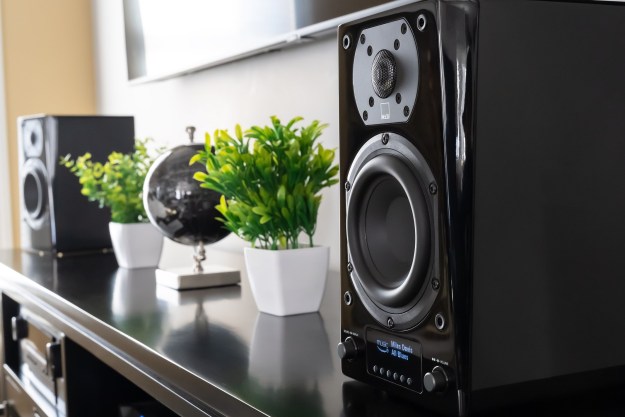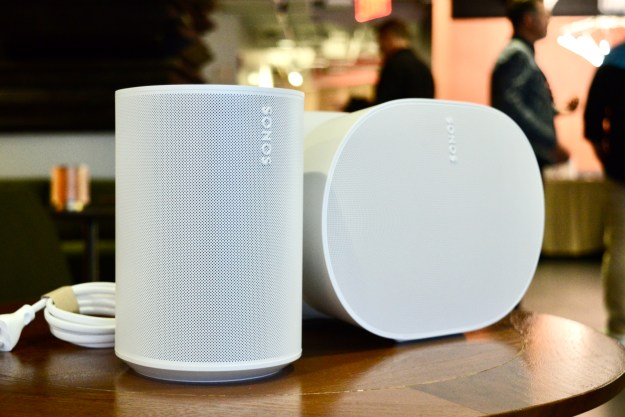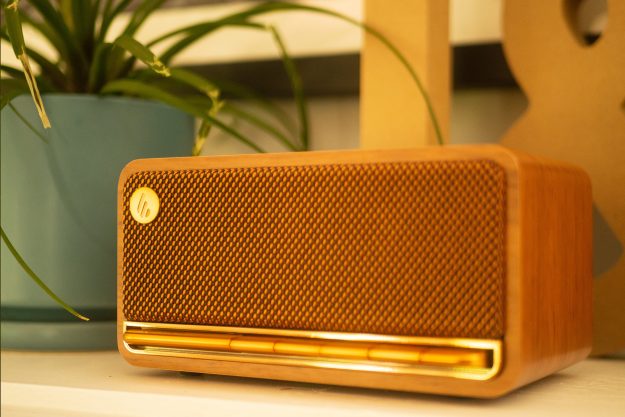
“The SVS Prime Wireless Pro offer high-quality home theater audio from a family-room-friendly footprint.”
- Outstanding sound quality
- Easy to set up/use
- Comprehensive connectivity
- Great for music, movies, TV
- Can add subwoofer
- Onboard controls can be a distraction
Soundbars are shockingly good these days. But there are some scenarios in which a soundbar simply will not cut it. It is for those scenarios that this versatile powered speaker system was created.
Meet the SVS Prime Wireless Pro powered speakers.
Don’t get me wrong, I’m a big fan of how far soundbars have come over the past few years. But as great as the Klipsch Cinema 1200, the Sonos Arc, and the Samsung Q990B all sound for home entertainment, those super-premium soundbar systems still leave me a little cold for music listening. They all kick out some impressive surround sound for movies and TV. But for really satisfying music fidelity, with detail and sound stage width and depth — you know, sit-down music listening — I still prefer a more traditional, independent speaker system. That’s what I have in my living room. The problem is, my living room system, with the big AV receiver and tower speakers, is a bit of a space hog.
Powered bookshelf speakers make a good alternative for those who want big sound with a small footprint. But what powered speakers have historically lacked is an HDMI ARC connection so they can be used for music, as well as movies and TV.
That’s where the SVS Prime Wireless Pro come in. The Pro model of the Prime Wireless have an HDMI eARC interface built-in, along with just about everything else you’d want from a wireless speaker, making them an outstanding alternative to a soundbar.
As I dived into the Prime Wireless Pro, I was reminded of Klipsch’s The Fives. Those were the first powered speakers to sport an HDMI interface, and I loved them. Of course, now there are several powered speaker options from multiple brands, but I’ve been looking forward to seeing how the Prime Wireless Pro compare to The Fives specifically, given they remain one of my favorites in the product category.

Design
From a design perspective, the Prime Wireless Pro start out looking a lot like SVS’ Prime Bookshelf speakers. A little bigger than some 5.25-inch bookshelf speakers, but not gargantuan by any means at about 11.5 inches high, 7 inches wide, and 9 inches deep.
Above the 5.25-inch mid-bass driver is a 1-inch aluminum dome tweeter, and those drivers each get their own 50-watt amp for a total system power of 200 watts. On the back, you get the eARC HDMI port I mentioned, along with a digital optical port, line-in via RCA or a 3.5mm headphone jack, and a subwoofer output.
You’ll get an Wthernet port, but the SVS Prime Wireless Pro also offer Wi-Fi and Bluetooth, for which AptX, Chromecast, AirPlay 2, DTS PLay-Fi, and Spotify Connect are all supported.
The DAC built into these speakers supports up to 192 kilohertz at 24-bit, so you can get lossless via DTS Play-Fi’s Critical Listening mode (app required), and CD-quality from
The USB port is a service port and can also support wireless audio adapters, but it is not set up as a USB audio receiver. So if you want to use a PC, you’ll want to use optical, wireless, or an outboard DAC and one of the analog inputs.

Controls
The front of the primary (right-hand) speaker has two dials and six preset buttons along with a dimmable display. I appreciate the functionality for desktop applications — having those controls at your fingertips is helpful, and the presets are convenient for one-touch access to playlists or streaming services. I also appreciate that the display clearly tells you what input you’re on and even has a readout for what you’re listening to from
On another note, I have to say that the gloss-white piano finish is super nice. Since we often bring in speakers in a white finish to add contrast to our videos, I thought they would photograph well for me — and they did — but I’ve found myself wishing I had gone with the gloss-black version.

Setup
Setup is super easy. I connected an Ethernet cable because I have one nearby, but I also connected to Wi-Fi with no problem. Bluetooth was similarly easy to set up, but honestly, I didn’t use it much since Wi-Fi was available. And as for speaker setup itself, there’s not much to do but plug in the power cable for the primary speaker, then run a custom four-pin cable over to the left speaker – a cable, by the way, that I think will be long enough for most applications. I don’t think these speakers should be placed any further apart than the included 8-foot cable will allow, but if you did want to do so, you’d need to source a longer cable yourself.
As for the HDMI connection – these speakers only accept PCM audio – there’s no Dolby or DTS decoder built in, which is normal. So if you get these speakers for your home entertainment system, make sure you go into your TV’s settings and set the digital audio output to PCM – most TVs won’t figure that out automatically, so you need to do it manually, otherwise, you will get zero sound from your TV.
Sound quality
The first notes I heard coming out of them was a YouTube video played on the Sony A95K’s YouTube app. It was a Zildjian Live music video featuring Larnell Lewis with the band Ghost-Note , and my expectations were low because compressed YouTube audio rarely sounds great. But what I heard had me in disbelief.
“No way is all that sound coming from those speakers,” I thought. I knew I hadn’t turned on the subwoofer SVS sent me or even connected a subwoofer cable, but I still walked over to double-check anyway, because I was hearing bass at least down to 60Hz, and I suspected lower.
Still in some disbelief, I ran some frequency sweep patterns, and my measurements confirmed that these speakers are indeed getting down to 40Hz with authority, and have audible bass down to 35Hz. In fact, I tracked down to 32Hz, which is insane. I’ve helped design 6- and 6.5-inch bookshelf speakers much bigger than these that couldn’t pull off that kind of bass. I suppose we have the magic of DSP to thank for this.

But here’s the thing: These speakers don’t sound like they are muscled by DSP. Definitely not the way soundbars often do, and not even like many powered speakers can. They actually sound remarkably natural — which is not to say they sound neutral. They definitely have an SVS sound profile — it just happens to be a sonic signature I like a lot.
On the other end of the spectrum, I’m again pleasantly surprised by the high-frequency response on these speakers. I’m generally not a fan of metal-dome tweeters, but SVS’ work with them is one notable exception.
You get a lot more than you pay for.
I’d describe the highs as being just slightly laid-back. Don’t get me wrong, there is plenty of detail and resolution here. I get the grit of brass overtones, the shimmer of cymbals, and plenty of breathy air around close-miked vocals – but compared to, say, Klipsch’s The Fives, which are a bit more in your face, the Prime Wireless Pro managed to have good presence without being quite so forward. I like it a lot.
The midrange is solid. It’s not as open and transparent as, say, the KEF LS 50 Wireless II, but it is surprisingly close. And that’s saying something considering the vast price difference. There’s no chestiness or honk to the meat of the vocal range, and guitar – especially guitar – has tremendous clarity and tonality in the core of the range. I mean, we’re talking audiophile-level stuff here.
There wasn’t a single musical genre I tested that fell outside of the range of the Prime Wireless Pro’s abilities. Hip-hop, R&B, jazz, classical, reggae, bluegrass, yes, even country and Western (so, both kinds of music) — it all sounded excellent. I mean, honestly, I feel like you get a lot more than you pay for with these speakers, especially when listening to music.
One of the best deals in high-quality two-channel sound you can get.
And they do movies really well, too. For the best hom theater experience, though, you would want to add a subwoofer — like the SVS Micro 3000 – that would allow you to keep the small footprint while adding some more punch and rumble that you need for the LFE track in movies. Musically speaking, I could very easily go without a subwoofer – the bass on the Prime Wireless Pro is just so incredibly deep and musical, with just the right amount of punch. And they do better than most powered bookshelf-sized speakers do for movie-watching. But for the kind of bass you expect from a soundbar system or home-theater-in-a-box, a sub is warranted.

I’ll recommend these to anyone who’ll listen
The Prime Wireless Pro offer one of the best deals in high-quality two-channel sound that you can get. Compared to the Audio Engine 5+, they do cost about $300 more, but you get $300 more in resolution, detail, and articulation. And, frankly, the better bass is the payoff there. And as much as I love the KEF LS 50 Wireless II, the Prime Wireless Pro make them a harder sell because they offer more prominent bass and punch up so close to the KEF for considerably less money. Also, the HDMI connection is no small deal, in my opinion.
As for value, consider that, within SVS’s own lineup , were you to purchase a pair of passive gloss black or gloss white Prime Bookshelf speakers and add a respectable amplifier, the pairing would cost more than the complete Prime Wireless Pro package, and would lack the convenience of a one-box solution.
If it wasn’t for the little aesthetic hang-up I have with the right speaker’s dial and display – which might be a zero issue for you; I’m just overly particular, I guess — these would be a 10 out of 10. I’ll give ‘em a 9.5, though. They tick just about every box for me.
So, whether you listen exclusively to vinyl, are a die-hard high-resolution digital audio person, or need a home entertainment system that doesn’t gobble up space – any situation in which you want highly musical sound that extends beyond what a soundbar can do, but doesn’t require the kind of financial investment and space requirements that a much larger traditional two-channel setup requires? — the Prime Wireless Pro are the ticket. Bring them home, and get ready to have your expectations blown away.
Editors' Recommendations
- Best wireless speakers for 2024: Sonos, JBL, KEF, and more
- Earfun Free Pro 3 wireless earbuds will make you question Apple’s prices
- New Klipsch tabletop wireless speakers are a more affordable, capable take on mid-century modern
- JBL’s retro-style wireless speakers could spark serious envy among Sonos fans
- Klipsch cranks up the karaoke with its first wireless party speakers





